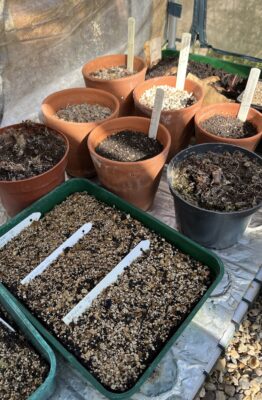It’s a busy time in the greenhouse. Sow courgettes, climbing and dwarf beans, chard, beetroot, salad onions and tender herbs including basil and coriander. ‘Harden off’ and plant outdoor pumpkins, melons and tomatoes and courgettes in their permanent positions once the danger of frost has passed. Plant courgettes into organic rich soil, trough slits in thick black plastic or corrugated cardboard keeps the fruit clean. Black plastic also warms the soil for faster growth and can be recycled annually.
Sow outdoor ridge cucumbers, for planting out in early June, speed germination by sowing in a heated propagator, if you can.

In some areas, it is still too early to plant out annual bedding, especially early in the month if the weather remains wet and cold and it is also a waste of money. Instead, plant up hanging baskets and summer containers and leave them in the greenhouse to establish, before moving them outdoors when temperatures rise and the weather settles. Choose your plants carefully; select colours that work well together in bright or pastel shades and roughly work out how many you need and the style you are looking for before buying. Buy them from a reputable garden centre with a high turnover of stock. Choose plants that are compact, pest and disease free with no signs of yellowing, make sure there aren’t masses of roots growing through the drainage holes and that the compost is moist, showing they have been well cared for. Before moving your container displays permanently outside, acclimatise them for a couple of weeks in the green house, leaving them outside during the day and bring them into the glasshouse at night. When they are finally planted out, move them carefully move containers in a wheelbarrow rather than carrying– you may need help – and boost early flowering and toughen growth with high potash general fertiliser and a couple of doses of liquid seaweed.
Check greenhouse seedlings at least daily, only watering if necessary. They need watering less often when light and temperature levels are low. Use tepid tapwater and beware of overwatering.
Continue to inspect plants daily; look out for aphids, and whitefly and red spider mite on shoot tips and the underside of leaves. Use organic spays for aphids and whitefly and increase the humidity around plants by misting with soft tepid water to discourage red spider mite – they dislike dry air. Planting French marigolds in the greenhouse will discourages whitefly but only when they are in active growth.
Tie in the main stems of tomatoes, peppers and aubergines firmly into canes as they grow, to support the growing stems. Use soft string or raffia, don’t tie them too tightly and check regularly so they don’t cut into the expanding stems.
Continue to prick out and pot on seedlings, before they become ‘pot bound’ gradually increasing the pot by a one or two sizes each time until they reach the final pot where they are to reach maturity.


